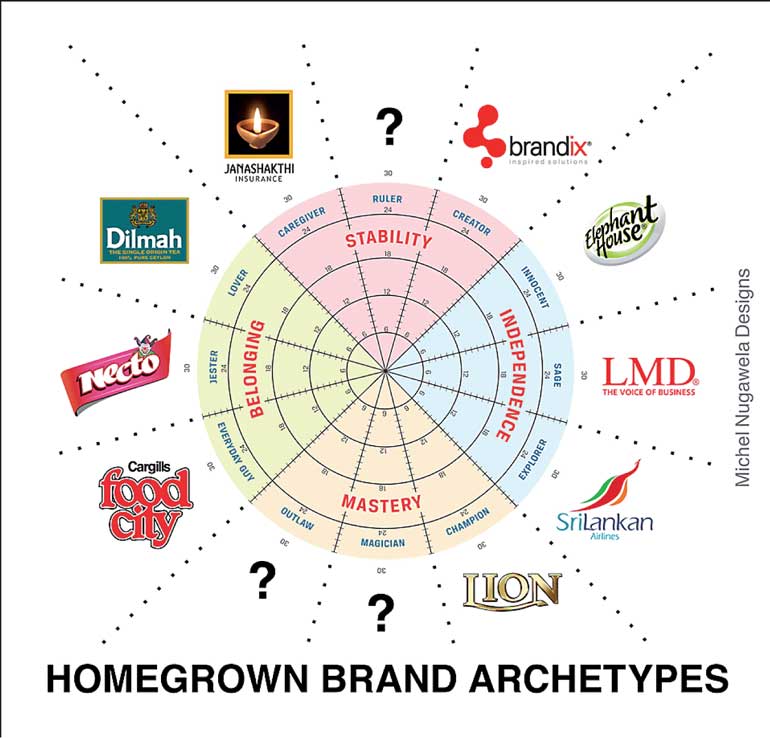Sunday Apr 20, 2025
Sunday Apr 20, 2025
Thursday, 9 July 2015 00:00 - - {{hitsCtrl.values.hits}}

Michel Nugawela
Top brand development consultancy Michel Nugawela Designs complements its full suite of brand strategy, brand architecture, brand identity and packaging development with the introduction of brand archetyping. This is Michel Nugawela’s second initiative in the paradigm-shifting field of Jungian psychology this year.
Archetypes represent symbols, themes, settings, or character types in the collective unconscious of the human psyche that recur across time, generations, cultures, industries and markets. The 12 primary archetypes – the Innocent, Regular Guy, Warrior, Caregiver, Explorer, Lover, Outlaw, Creator, Ruler, Magician, Sage and Jester – symbolise fundamental human motivations and meanings found across the categories and segments brands compete within. These include the complete spectrum of consumer values and goals that frame brand archetypes within the two human motivational dimensions of Stability versus Mastery, and Belonging versus Autonomy dynamics.
When the Caregiver, Ruler and Creator archetypes lead, consumers take control of situations to make life predictable and stable while the Outlaw, Magician and Champion archetypes take great personal risks to change reality by realising their own special power. The Lover, Jester and Everyday Guy archetypes seek connection, interaction and fitting in with the wider group while the Innocent, Sage and Explorer archetypes emphasise autonomy over belonging and their selves over others.
“The most successful and profitable brands consistently emulate the behaviour of a particular archetype,” says Nugawela. “For example, the Anchor mother is the archetypal Caregiver – nurturing, loving, self-sacrificing and devoting herself to her children and family. Meanwhile, Lion Lager is the archetypal Champion brand where male consumers perceive themselves to have the discipline, courage and strength to overcome the obstacles life throws at them and defend the underdogs in society – hence the brand development process creating the Lion sinhaya proudly standing atop the rock.”

Brand archetyping provides marketers with the tools and techniques to craft the positioning and anchor the brand against the archetypal patterns that are deeply rooted in the target consumers’ conscious and unconscious minds. “Through the lens of these 12 primary archetypes and a further 60 sub-archetypes, we analyse aspirations, attitudes, behaviours, lifestyles, the competitive framework, visual imagery and brand perceptions,” says Nugawela. “These are then shaped into a highly singular, differentiated, and powerful direction that is instantly understandable to the target customer or consumer.”
The holistic and intuitive approach also results in powerful organisational buy-in as internal and external stakeholders who contribute to the brand positioning through ongoing brand management, product development, distribution strategies, consumer research, and brand communications gain razor-sharp clarity of what a brand archetype symbolises and stands for. This leads, in turn, to an extremely consistent and meaningful consumer experience across multiple touch points and channels in the market. “Importantly, marketing teams and brand custodians are also able to discover the archetypal patterns of competitive products, brands, campaigns and categories and to respond with highly effective strategies and tactics.”
Michel Nugawela specialises in brand creation and revitalisation to drive consumer/customer demand, growth, and profitable turnarounds. He has branded and repositioned many of Sri Lanka’s most renowned and respected brands, including Aitken Spence PLC, Hayleys PLC, Dipped Products PLC, Nations Trust Bank PLC, HNB Acuity, Heritance Hotels & Resorts, Lion Lager, Elephant House, and Carson Cumberbatch PLC’s regional palm oil businesses in Indonesia, Malaysia, Singapore, and India.
He brings over two decades of entrepreneurial expertise in senior level corporate consulting and a record of achievements in brand strategy and positioning, brand architecture, new product/service and value proposition development, messaging strategies, corporate and brand identity development, packaging design, evaluating and determining the role of brands in complex situations such as mergers, acquisitions, spin-offs, and diversifications, and related specialisation in change strategies across newly rebranded or repositioned organisations that result in new mindsets and behaviours by individuals and teams.